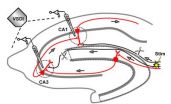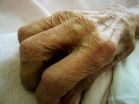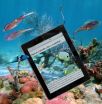(Press-News.org) Jewish women who were severely exposed to hunger during World War Two were five times more likely to develop breast cancer than women who were mildly exposed, according to research in the October issue of IJCP, the International Journal of Clinical Practice.
The study also found that women who were up to seven-years-old during that period had a three times higher risk of developing breast cancer than women who were aged 14 years or over.
Sixty-five women diagnosed with breast cancer between 2005 and 2010 were compared with 200 controls without breast cancer. All the women lived in Israel. The women with breast cancer were recruited from five medical centres and the controls were members of various organisations for Jewish World War Two survivors.
"The women who took part in our study had all lived under Nazi control for at least six months" explains Dr Neomi Vin-Raviv from the School of Public Health at the University of Haifa, Israel. "We were keen to see what effect restricted calories during this period had on the development of breast cancer and how exposure at an early age, before breast development, affected the potential risk.
"We believe that our findings will be of interest to clinicians treating women involved in any situation such as war and famine, where food is scarce and hunger is severe."
Key findings of the study included:
Average age at interview was 76.2 years for the women with breast cancer and 78.3 years for the controls. Women with cancer were more likely to be obese and women in the control group were more likely to be overweight. There were no significant differences in smoking status, alcohol consumption, current physical activity and reproductive and gynaecological characteristics.
A much higher percentage of the women with breast cancer were seven years old or less at the time of World War Two (49.2%) than the controls (27%). 12% of the women with breast cancer were born during the War, compared with 7.5% of the control group.
63% of the women with breast cancer lived under direct Nazi rule, compared with 83.5% of the controls, and the remainder lived in "independent countries" that co-operated with the Nazi regime.
61.5% of the women with breast cancer experienced severe hunger, compared with 37% of the women without breast cancer. The figures for moderate hunger were 17% and 38% respectively and the figures for mild hunger were 21.5% and 25%.
The odds of developing breast cancer was five times higher in women with severe hunger than mild hunger. Being aged seven-years-old or less increased the odds by 2.8 times.
"The link between restricted calorie intake and cancer is a complex one" says Dr Vin-Raviv. "Several theories are discussed in our paper, but further research into the biological mechanisms are needed.
"What is clear from our study is that there was a clear association between severe hunger and breast cancer in Jewish survivors and that the women who were seven years old or younger during the War were the most affected group.
"These findings are of relevance not only to World War Two survivors, but to other communities that may be currently exposed to restricted calorie intakes."
###The paper is free online at: http://onlinelibrary.wiley.com/doi/10.1111/j.1742-1241.2012.02966.x/abstract
Note to editors
Severe caloric restriction in young women during World War II and subsequent breast cancer risk. Vin-Raviv et al. IJCP. 66.10, pp948. (October 2012). doi: 10.1111/j.1742-1241.2012.02966.x
IJCP, the International Journal of Clinical Practice, was established in 1946 and is edited by Dr Graham Jackson. It provides its global audience of clinicians with high-calibre clinical papers, including original data from clinical investigations, evidence-based analysis and discussions on the latest clinical topics.
http://wileyonlinelibrary.com/journal/IJCP
www.twitter.com/IJCPeditors
About Wiley.Founded in 1807, John Wiley & Sons, Inc. has been a valued source of information and understanding for more than 200 years, helping people around the world meet their needs and fulfill their aspirations. Wiley and its acquired companies have published the works of more than 450 Nobel laureates in all categories: literature, Economics, Physiology or Medicine, Physics, Chemistry, and Peace. Our core businesses publish scientific, technical, medical, and scholarly journals, encyclopedias, books, and online products and services; professional/trade books, subscription products, training materials, and online applications and Web sites; and educational materials for undergraduate and graduate students and lifelong learners. Wiley's global headquarters are located in Hoboken, New Jersey, with operations in the U.S., Europe, Asia, Canada, and Australia. The Company's Web site can be accessed at http://www.wiley.com. The Company is listed on the New York Stock Exchange under the symbols JWa and JWb.
Ants that are held as slaves in nests of other ant species damage their oppressors through acts of sabotage. Ant researcher Professor Dr. Susanne Foitzik of Johannes Gutenberg University Mainz (JGU) in Germany first observed this "slave rebellion" phenomenon in 2009. According to the latest findings, however, this behavior now appears to be a widespread characteristic that is not limited to isolated occurrences. In fact, in three different populations in the U.S. states of West Virginia, New York, and Ohio, enslaved Temnothorax longispinosus workers have been observed to ...
This press release is available in German.
The hippocampus represents an important brain structure for learning. Scientists at the Max Planck Institute of Psychiatry in Munich discovered how it filters electrical neuronal signals through an input and output control, thus regulating learning and memory processes. Accordingly, effective signal transmission needs so-called theta-frequency impulses of the cerebral cortex. With a frequency of three to eight hertz, these impulses generate waves of electrical activity that propagate through the hippocampus. Impulses of a different ...
Washington D.C., September 26, 2012 – The American Academy of Child and Adolescent Psychiatry (AACAP) is proud to announce its new Practice Parameter on issues related to and affecting gay, lesbian, bisexual, and gender variant youth.
Gay, lesbian, bisexual, and gender variant children and adolescents face unique developmental challenges and stressors that can influence their mental health and wellbeing. Social issues such as stigma, bullying, and discrimination, and personal factors like internalized prejudice and feelings of being different are just a few of the concerns ...
The combination of two neuroprotective therapies, voluntary physical exercise, and the daily intake of melatonin has been shown to have a synergistic effect against brain deterioration in rodents with three different mutations of Alzheimer's disease.
A study carried out by a group of researchers from the Barcelona Biomedical Research Institute (IIBB), in collaboration with the University of Granada and the Autonomous University of Barcelona, shows the combined effect of neuroprotective therapies against Alzheimer's in mice.
Daily voluntary exercise and daily intake ...
What does a yoghurt look like over time? The food industry will soon be able to answer this question using a new fluid simulation tool developed by the Department of Computer Science (DIKU) at the University of Copenhagen as part of a broad partnership with other research institutions. An epoch-making shift in the way we simulate the physical world is now a reality.
A five-year collaboration between the University of Copenhagen, the Technical University of Denmark (DTU) and the Alexandra Institute on simulating fluids in movement is now bearing fruit, and has earned the ...
Over millions of years, biological organisms – from the chameleon and cuttlefish to the octopus and squid – have developed color-changing abilities for adaptive concealment (e.g., camouflage) and communication signaling (e.g., warning or mating cues).
Over the past two decades, humans have begun to develop sophisticated e-Paper technology in electronic devices that reflect and draw upon the ambient light around you to create multiple colors, contrast and diffusion to communicate text and images.
And given the more than 100 million years head start that evolution has ...
The process for preparing frozen, par-fried potato strips — distributed to some food outlets for making french fries — can influence the formation of acrylamide in the fries that people eat, a new study has found. Published in ACS' Journal of Agricultural and Food Chemistry, the study identifies potential ways of reducing levels of acrylamide, which the National Toxicology Program and the International Agency for Research on Cancer regard as a "probable human carcinogen."
Acrylamide forms naturally during the cooking of many food products. Donald S. Mottram and colleagues ...
Cod are among Sweden's most common and most popular edible fish and have been fished hard for many years. One consequence is the risk of serious changes in cod stocks, reveals research from the University of Gothenburg, Sweden.
In overfished areas, there is often a shortage of large and old cod, and the fish become sexually mature at a younger age. Researchers have feared that this change may have impacted on the fish's health, physiological ageing and reproductive capacity.
In a recently published study, a research group from the University of Gothenburg working with ...
The search for a "greener" way to prevent corrosion on the kind of aluminum used in jetliners, cars and other products has led scientists to an unlikely source, according to a report in ACS' journal Industrial & Engineering Chemistry Research. It's the juice of the date palm — those tall, majestic trees that, until now, were noted mainly as sources of food and traditional medicines.
Husnu Gerengi points out that strong, lightweight aluminum alloys are used to make planes, cars and industrial equipment. Aluminum corrodes when exposed to air, but unlike rusting steel, the ...
Philadelphia, Pa. (September 26, 2012) – Same-sex partners and inconsistent condom use were among the major risk factors for HIV infection among U.S. Navy and Marines personnel during the "Don't Ask, Don't Tell" (DADT) era, reports a study in the October 1 issue of JAIDS: Journal of Acquired Immune Deficiency Syndromes. The journal is published by Lippincott Williams & Wilkins, a part of Wolters Kluwer Health.
"[M]ale-to-male sexual contact was a much more common mode of infection than previously reported," reports the new study, led by Shilpa Hakre, DrPH, MPH, of the ...


